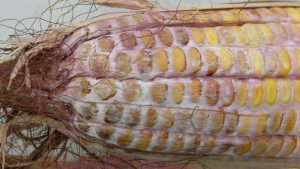Making cover crops economical
USING DRONES AND AI TECHNOLOGY

ACCURATELY MEASURING THE nitrogen credit left over after a red clover cover crop has been a challenge for many farmers — until now. Jordan Sinclair, data scientist with Veritas Farm Management, is diving into research on using data analysis to track nitrogen credits left over from a double cut, red clover cover crop. This collected data will be used to write an algorithm that can confidently write nitrogen scripts for the most precise amount of nitrogen that is needed in corn fields where red clover was planted the year prior.
Red clover is a common cover crop inter-seeded into winter wheat that can add organic matter to soil, prevent soil erosion, and improve water holding capacity as well as improve water movement through the soil. Red clover is also an efficient nitrogen fixer. The challenge facing this cover crop, however, is the inconsistencies in stand count. Red clover can be outcompeted by the existing growing crop thus providing an inconsistent stand and inconsistent nitrogen credit throughout the field for the following year’s corn crop. This leads many farmers to apply nitrogen to fields as if there wasn’t any nitrogen fixated in the soil.
“The main challenge with the clover is that it grows in a patchy nature across the field, so its hard for the farmers to really utilize the credit from the clover,” explains Sinclair. “To hedge their bets or play it safe, many [farmers] are applying nitrogen as if they didn’t get any.”
RESEARCH
The goal of this research project is to accurately determine the nitrogen credits left in a field by combining Unmanned Arial Systems (UAS) technology — drones — and Artificial Intelligence (AI) technology. The drone technology is used to measure red clover plant counts and biomass at the field level, and then the data collected is used to create an AI algorithm to write nitrogen scripts for what needs to be applied to meet the corn crop’s nitrogen requirements.
“We have all the technology now to measure [nitrogen credits] and then write the script. The only missing link is what credit is assigned to what area of the field and so that is the missing piece that we’re trying to figure out,” says Sinclair.
Once the nitrogen scripts are developed, they can be implemented using variable rate technology to accurately and precisely apply nitrogen for a growing corn crop.
Research is currently occurring in 21 fields across nine counties in southern Ontario. At the end of the three-year study, Sinclair hopes to have enough data from across Ontario to create a wide-ranging algorithm that can be used by farmers and agriculture service providers.
Sinclair explained that a wide variety of farms have been chosen for the research. Different operations are being used in the field studies to better understand exactly how much nitrogen is credited to the soil regardless of what farming practices are being used.
“We’re hoping at the end of this we have a robust data set that [represents] a wide breadth of farming practices in addition to geographies so that every farmer will be able to take something of this and feel confident that this could work on their farm.”
SAVINGS
On average, 800,000 acres of winter wheat are planted each year in Ontario and of that, 20 per cent is under seeded with red clover. It has been theorized that up to 70 pounds of nitrogen per acre can be credited after a red clover crop, but non-uniform stands prevent this credit from being used to its potential. An average credit is instead used when calculating and purchasing nitrogen fertilizer thus leaving some areas over credited with nitrogen and other areas under credited of the nutrient.
Nitrogen fertilizer averages at $0.50/lb. There is an opportunity to save up $35.00/ acre by maximizing the use of the credited nitrogen versus purchasing nitrogen inputs.
“The goal of this project is to try to make cover crops a little more economically reasonable. You can utilize the nitrogen sequestered by the clover to reduce your nitrogen bill in the spring,” says Sinclair.
RESEARCH PRIORITIES
Sinclair’s research project is a jointly funded by Grain Farmers of Ontario, Veritas Farm Management and Green Eye Technology.
“Red clover is still an effective cover crop, but it can be difficult to establish well in a field,” says Dr. Josh Cowan, manager of research and innovation at Grain Farmers of Ontario. “This new technology being proposed would enable [farmers] to still identify credits in areas where the clover did establish. This will help improve its place in a cropping system while we continue to work on the establishment challenge.”
This research project also fit well into Grain Farmers of Ontario’s 2019 research priorities. Each year, specific priorities are identified for investment and in 2019, priorities included quantifying the impact of standard field practices on soil health and developing strategies to improve or maintain soil health.
This research project received funding from Grain Farmers of Ontario. •

























